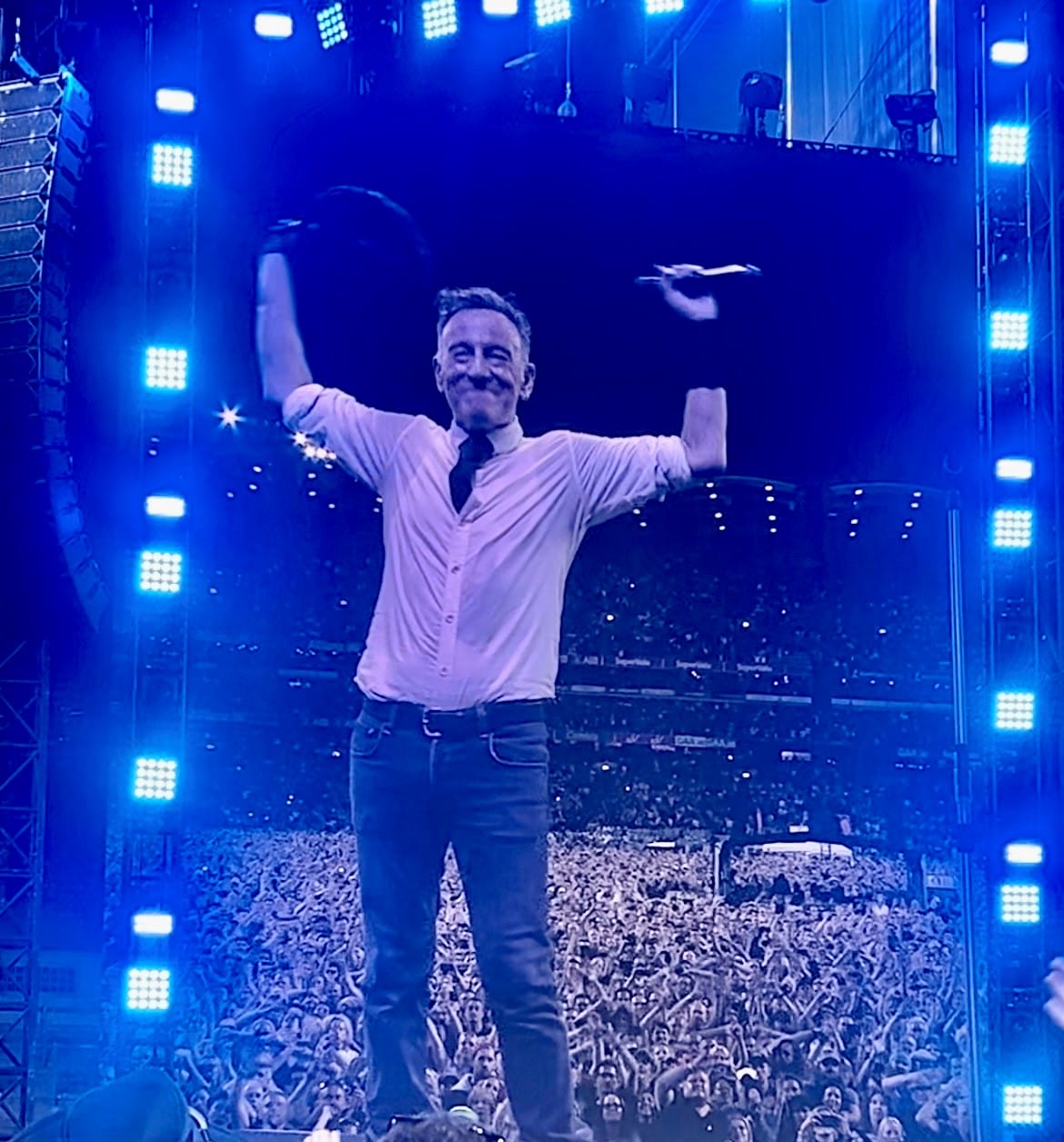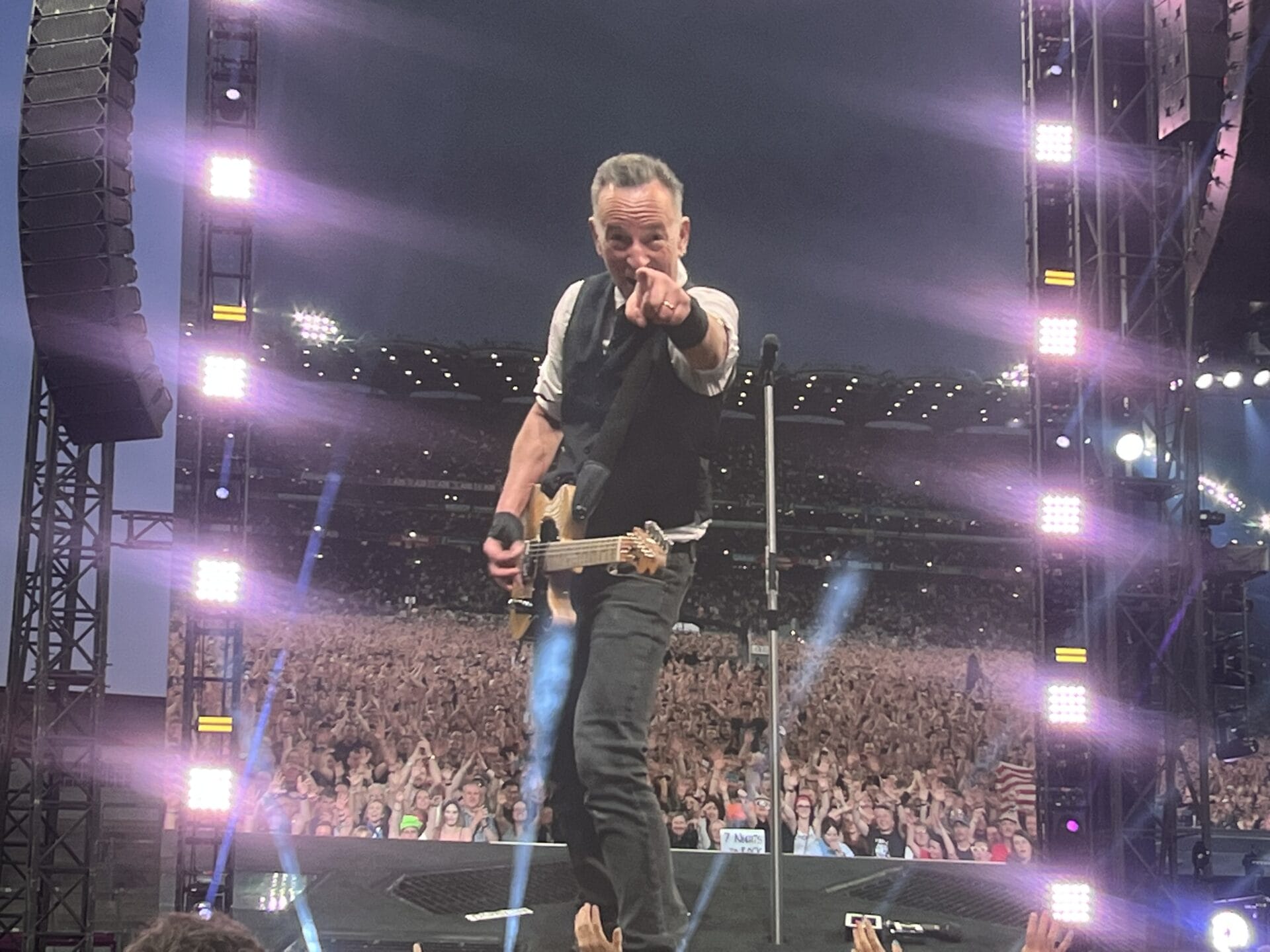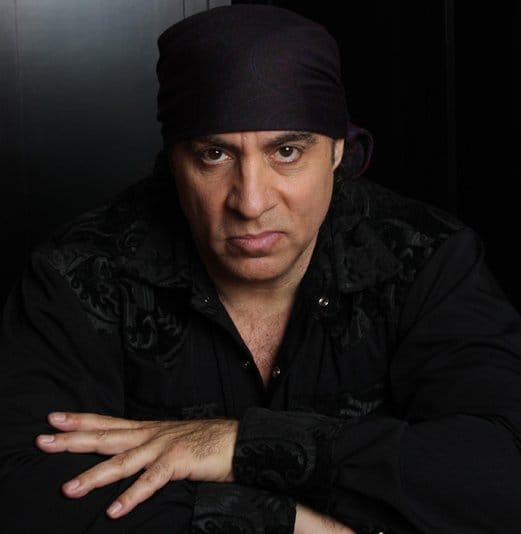By Mary Moynihan
Bruce Springsteen and the E Street Band played four nights in Ireland, culminating in a gig in Croke Park on 19 May, 2024. The show was a top-class performance and the atmosphere was joyful and euphoric. It was described by Ed Power in the Irish Times as a ‘blockbuster performance’.
The show started at ten-past-seven with ‘Lonesome Day’, ‘Night’ and ‘No Surrender’ as Springsteen said ‘Good evening Dublin, we have come to rock you.’ Springsteen and the E Street band performed over twenty-five songs including ‘Two Hearts’, ‘Ghosts’, ‘Hungry Heart’, ‘My Hometown’, ‘The River’, ‘Because the Night’, ‘She’s the One, Burn to Run’, ‘Dancing in the Dark’, ‘Thunder Road’ and ‘Darlington County’. They even sang ‘Twist and Shout’ which had the entire stadium dancing along. At the end Springsteen sang a moving rendition of ‘Rainy Night in Soho’ as a tribute to Shane McGowan and the Pogues.
There were moments of poignancy when Springsteen talked about people who have passed on and the importance of keeping lost loved ones in our hearts. Springsteen said ‘the grief that we feel is the price we pay for having loved well.’ He played the haunting ‘Last Man Standing’, which is inspired by the fact that Springsteen is the last living member of the first band he was in, The Castles.
Two things stood out. The first is Springsteen’s energy. With Springsteen, there is no such thing as getting old, it’s all about youthful ageing. This man is seventy-five this year, yet he performed a live show for three hours solid, with no break. His energy never seemed to wane. Springsteen and the E Street band have been described as an unstoppable force. There were a variety of instruments and support singers on stage and the whole combination created this magical forcefield of rock and rhythm that everybody in the audience tapped into. I hope I have the same energy as ‘the boss’, as Springsteen is often referred to, when I am his age.

Photo by Mary Moynihan
The second thing that struck me was Springsteen’s genuine sense of respect for, and connection with, the audience. He seemed genuinely grateful for the audience being there. He regularly went to the edge of the stage to interact with the crowd, giving away his harmonica to a young girl and continuing to smile and sing as women of all ages wrapped their arms round him like they would never let go. There is a saying by Constantin Stanislavski, the Russian theatre director and founder of the Moscow Art Theatre: ‘love the art in yourself, not yourself in the art’. With Springsteen he loves the artform and is dedicated to his craft, yet equally recognises that half of the circle is the audience he performs for. That was great to witness. Springsteen himself as well as the crowd all looked like they were having great fun and this fun is infectious. Not only are you listening to fantastic rock and roll but you are also having fun. I enjoyed Springsteen’s references on stage to the hard-rocking, Viagra-taking, love-making, death-defying E Street Band. Very life-affirming.
During the show Springsteen interacts with fellow band members including guitarist Steven Van Zandt. Van Zandt, also in his seventies, was an activist with the anti-apartheid movement and he wrote Sun City, a protest song against Apartheid in South Africa. Steven Van Zandt has said, referring to America, that ‘people don’t understand we’re the only country in the world that thinks art is a luxury. Everybody else in the world understands that art is an essential part of the quality of life’[1].
He and Springsteen met in Jersey when they were teens, and have been best friends ever since. Springsteen refers to Steve as the ‘consigliere of the E Street Band’. Van Zandt has acted in the Sopranos. They are two best friends’ side by side playing rock and roll music for over 50 years and you see that comradeship, love, and history on the stage. Springsteen has spoken about the support of the E Street Band and his friends and how he can open up with them as an artist, saying ‘The E Street band makes me dream, think and write big. When I am amongst my friends I allow a certain part of my mind that seems to be reserved for only them to be set free and I dwell in a house of a thousand dreams.’
According to Bruce Springsteen’s own website, he is lauded by Rolling Stone as the ‘embodiment of rock and roll’. With more than 140 million records sold around the globe and more than 70 million in the United States, Bruce Springsteen is one of the world’s best-selling artists. Long recognised as an incomparable live performer, he has won 20 Grammy awards, an academy award, two golden globes and a special Tony Award. Bruce Springsteen and the E Street band provided a fantastic night of entertainment, receiving a rousing response from the crowd of 80,000 people in Croke Park. Hopefully there are many more world tours to follow.

Photo by Mary Moynihan
Personal and Political Response to Bruce Springsteen’s Work
Some may say that Bruce Springsteen is not overtly political but a lot of his songs have a strong political flavour. In a number of tracks, he is singing about the lives and daily struggles of working-class people, particularly in a society that allows the rich to get richer and the poor poorer. Songs like ‘Bobby Jean’, ‘Born in the USA’, ‘The River’, and ‘My Hometown’ all refer to communities that have been ravaged by economic instability or war. The lyrics are subtle but impactful. For artists working in human rights, it is important that art never becomes didactic and that the artistic quality, beauty and poetical nature of the work is never sacrificed for the sake of the issue being explored. Springsteen is a master at this.
Two of my favourite songs by Springsteen (not played at Croke Park) show how the personal is very much linked to the political. In a song such as the brilliant ‘Devils and Dust’, which is the title track on Springsteen’s thirteenth studio album Devils and Dust, there is a mix of the familial and political. The song is a powerful meditation on the human cost of war and being placed in a position that is morally untenable. Like any great song it doesn’t give you answers but poses questions.
Well, I’ve got God on my side
And I’m just trying to survive
What if what you do to survive
Kills the things you love
Fear’s a dangerous thing
Another great song is ‘The Ghost of Tom Joad’, a hauntingly beautiful ode to the horror of poverty and the struggle of ordinary working people to survive. This song is steeped in American history in terms of music and literature. Springsteen wrote the song in 1995 and it was inspired by ‘The Ballad of Tom Joad’ by the American folk musician Woodie Guthrie. For both Guthrie and Springsteen, the song is inspired by a character, Tom Joad, from the 1939 novel The Grapes of Wrath by John Steinbeck. The novel is set during the Great Depression in America and tells the story of the Joads, a poor family of migrant tenant farmers forced out of their home by drought and economic hardship. Springsteen uses the character of the ghost of Tom Joad, but sets the song in contemporary times, reflecting on how little has actually changed. Despite the wealth of America, ordinary people still live in horrific, crippling poverty and have no place in society.
Wherever somebody’s fighting for a place to stand
Or a decent job or a helping hand
Wherever somebody’s struggling to be free
Look in their eyes, Ma, and you’ll see me.
The song also contains the spirit of working together as a community and how we need to come together to prevail in times of great injustice and depression, and it’s the same struggle whether in the past or today. It’s a very political song and has been done in several versions, originally as a sombre protest/folk song by Springsteen, and later in a collaboration between Springsteen, the E Street band and Tom Morello, an American guitarist, singer-songwriter and political activist who has played with bands including the rock band Rage Against the Machine, Audioslave and Prophets of Rage.

Steve Van Zandt. Credit: TeachRock
TeachRock
In terms of Arts and Human Rights, teachrock.org was set up by Steven Van Zandt with founding board members Bono, Jackson Browne, Martin Scorsese and Bruce Springsteen. TeachRock is an open educational resource with hundreds of multicultural lesson plans to choose from that are available free to teachers and students. It aims to keep music and the arts in schools and to empower young people through the arts. It is a curriculum based around the history of popular music that can be integrated into different school subjects such as history, languages, sciences or the arts, and its available to everybody.
It was created in response to music being cut in schools in the United States and to high drop-out rates of young people. The aim is to use popular music and rock and roll to engage young people, keep them in school and support them to succeed. Educators from anywhere in the world can register with teachrock.org and the organisation has educators from the United States as well as England, Spain, Norway and elsewhere.
TeachRock has a range of lessons in the birth of rock and roll coming out of gospel, blues, country, jazz and R&B, and how rock brought people together across religious, ethnic and class lines. There are lessons linking rock and roll to sexual and gender liberation, teenage rebellion, and to the civil rights and black power movement, exploring how music was used to express sexual freedom, working-class liberation and the idea of protest and wanting to change the world. It also looks at the fragmentation of rock culture as time went on, and the importance today of keeping alive the spirit of music as something that brings people together. It refers to Bob Dylan winning the Nobel prize for literature in 2016 which generated fierce debate at the time, but importantly, it sent out the message that lyrics are literature. It looks at the integration of music with subjects such as maths and science and the importance of music in social and emotional learning.
Van Zandt says he recognised that as artists they were getting older and they wanted to pass on the power of music to the younger generation. He sees the arts as a common ground bringing people together worldwide and he wants to support integrating the arts into every curriculum in every school. He believes that through this society may return to the optimism of the sixties. He says ‘the curriculum is my way of saying thank you to that period and to all the people who turned me on to art and gave me dreams to believe in.’ Van Zandt has a lovely quote when talking about why he set up the curriculum (which he worked on for fifteen years before it was launched). ‘All I wanted was for every kid in kindergarten to be able to name the four Beatles, dance to Satisfaction, sing along with Long Tall Sally and recite every word of Subterranean Homesick Blues. The rest will take care of itself.’
Listen to ‘The Ghost of Tom Joad’ here and ‘Devils and Dust’ here.
Sources
https://teachrock.org/
[1] https://www.cbsnews.com/news/steven-van-zandt-e-street-60-minutes-transcript/#:~:text=I%20can’t%20be%20replaced,Rolling%20Stones%20invited%20us%20in.
